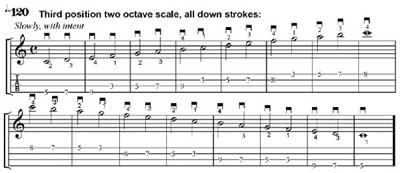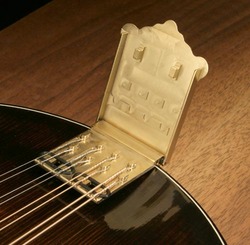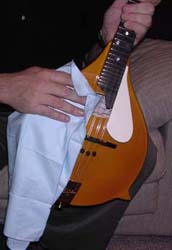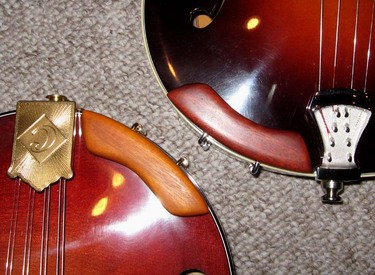« August 2008 |
Main
| October 2008 »
 September 25, 2008 | Mandolin Print Music Acquisition Syndrome
September 25, 2008 | Mandolin Print Music Acquisition Syndrome
Is this a familiar story? You go out and buy this great new method book or literature, take it home and play a few pages, then it gets tucked back into your dusty library full of books that you never used more than a couple times. Everytime you buy a book you stare at the shelf and ponder why you bought something new when you haven't yet dug deep into materials you already have.
If this describes you, welcome to club, victims of Mandolin Print Music Acquisition Syndrome. (MPMAS) There is nothing to feel guilty about or ashamed of, and we're here to comfort you with some rationalization to get over it.
First of all, there are far worse habits spending money on. Dropping a few Benjamins at the race track or slots never did you any good, and you have much more to show for it. The price of a private lesson with a great teacher or clinician can easily be from $50 to $100 or more. What's your average book cost, $8? $25? You still have something to go back to. Sometimes we get all wrapped up in the 70 pages we didn't use when we forget the 3 pages we did use changed our playing radically.
A Junior High teacher placed a small white mark in the corner of an otherwise clean chalkboard. She asked one of the class, "What do you see on the board?" The answer, "A tiny chalk mark."
She asked several other students, only to get the same answer repeatedly. Her remark? "What's wrong with you children, can't you see all this other clean space ready to be written on?!?!"
Yes, it's good to go back to collected print music and study things you missed the first time, but don't let inaction stop you from acquiring new books. Perhaps you're at a point where you're ready to take your playing in a new direction. New materials can be tremendously inspirational, priming you for all kinds of new musical directions.
Books are also great for sharing. Perhaps you can trade with other musicians, or just donate an unused book to someone who could benefit from them.
We really live in a wonderful era of information acquisition. New technologies have completely redefined what a book is. From 4-color printing, to PDF exchangeable formats online, to support audio and video materials on DVD and on the internet, there's never been a better time to learn.
Take advantage!
Visit our Free Download Page: Popular Downloads

Posted by Ted at 1:27 PM
 September 18, 2008 | A look back: Sweeping for tone
September 18, 2008 | A look back: Sweeping for tone
In the pursuit of great mandolin tone, we often overlook the obvious. We start looking for the ultimate instrument, at least one that's within our budget (or slightly more), or we think of changing the strings, or accessory aftermarket products like tone-gards or armrests--all the peripheral "stuff" we can add to our equipment. If we're even more mature in our playing, we've also thought of a good shop adjustment or other physical tweaking, but what we really ought to be concentrating on is our articulating hand.
Everything starts with a pick. Without a strident, clean attack and stroke follow-through, you don't stand a chance of creating, let alone maintaining good tone. We covered this very thoroughly in an old MandolinSessions article, and if you haven't seen this for a while, it deserves digging up: Thinking Good Tone Part 2; Using the picking hand to start Good Tone. We recommend looking at the accompanying exercise again: Sweeping for Tone

Again, speed is very important, or more properly, lack thereof! This must be played SLOWLY, and let's just all admit there is no way we can do this accurately or with discipline sans metronome. What you are striving for is the best articulation possible, with full concentration on the pick strike, follow-through, and preparation for the next strike. It's like a coach preparing for a game. You have the preparation, the actual game, and the post-game survey to figure out what you're going to do next time. Play this with full attention to the tone of each note!
Go back and review the instructions in the MandolinSessions article for tips on how to discipline yourself, not only in playing this through, but incorporating it in the larger picture regimen of your practice.
Just like in sports; nothing better than a clean sweep!
Read previous MandolinSessions archived articles.
Posted by Ted at 5:23 AM
 September 11, 2008 | Tools of the Trade: Five Tips
September 11, 2008 | Tools of the Trade: Five Tips
We'd like to make this a regular feature, five simple ideas involving basic equipment improvements and suggestions for making your mandolinning more effective and enjoyable. We'll start with five now, and if you want to suggest more, we'll post another five in future articles, "More Five Tips."
Getting into the groove: pencil lead in the string slots. This is an old fiddler's trick, but sometimes you get a string that just doesn't want to settle in when you're fine tuning. It jerks high, jerks low, and sometimes that's because of friction in the nut slot near the top of the strings. Simple pencil lead in the nut grooves can give you the minimal lubrication necessary to smooth the settling of the string.
 Trumpet slide grease on the grommets: lubing a Bill James Tailpiece. If you have a Bill James Tailpiece (highly recommended!), you might have heard sometimes the tailpiece won't stay closed or it had lost its "burp" when you softly tamp it down. This could be because of a small angle adjustment (loosen the strings and bend the tailpiece slightly upwards), or simply because the neoprene gaskets have dried or lost their friction. Pros will tell you a tiny dab of Vaseline will help lock this down, but we prefer a brass player's trick--trumpet slide grease, particularly Schilke Slide grease with Lanolin. This doesn't dry out and flake over time like petroleum jelly. Trumpet slide grease on the grommets: lubing a Bill James Tailpiece. If you have a Bill James Tailpiece (highly recommended!), you might have heard sometimes the tailpiece won't stay closed or it had lost its "burp" when you softly tamp it down. This could be because of a small angle adjustment (loosen the strings and bend the tailpiece slightly upwards), or simply because the neoprene gaskets have dried or lost their friction. Pros will tell you a tiny dab of Vaseline will help lock this down, but we prefer a brass player's trick--trumpet slide grease, particularly Schilke Slide grease with Lanolin. This doesn't dry out and flake over time like petroleum jelly.
 Silkweave a day: keep the finish its best. A cloth in the case along with a daily routine of mere seconds of wiping grime and sweat of your instrument's top, back, and fingerboard will pay you back in spades preserving the finish over time. It's a good habit like brushing your teeth, and if you do it every time you put your ax back in the case, you'll probably never need polish. We all have different body chemistries that impact our instrument in diverse severity, but a good cloth and polish routine is a hedge against cosmetic deterioration. Ultimately a seller's personal "Mojo" is a customer's depreciation. Check these out: Jupiter Silkweave Cloth. Silkweave a day: keep the finish its best. A cloth in the case along with a daily routine of mere seconds of wiping grime and sweat of your instrument's top, back, and fingerboard will pay you back in spades preserving the finish over time. It's a good habit like brushing your teeth, and if you do it every time you put your ax back in the case, you'll probably never need polish. We all have different body chemistries that impact our instrument in diverse severity, but a good cloth and polish routine is a hedge against cosmetic deterioration. Ultimately a seller's personal "Mojo" is a customer's depreciation. Check these out: Jupiter Silkweave Cloth.
A McClung armrest: better hand position, control, and comfort. We've raved about these before in a new item: read archive. Traditionally, much attention is paid to pickguards and tone-guards, but a simple armrest not only protects the front finish, it helps put the arm in better posture and frees the top vibration. Try one; you'll never go back.

Crimping your style: marking your string length with a bend... You're not likely to meet anyone who actually enjoys changing strings, but after you've done it a few times you start to develop your own personal tricks. The key to a good lock in the headstock is the initial bend you put on the string, and most of the time you're worried about the loop end. We suggest locking the loop, holding the string into place with your forearm on the finger board and pulling the string all the way through the tuner. Now pull it back 2-1/2 to 3 inches and pull a bend upwards with extra end. This is your reference point for where the string will land after completely tensioned. Get it right the first time; a properly positioned lock is the key to a securely tuned string.
Let us know your tips: Contact
Posted by Ted at 6:14 AM
 September 3, 2008 | Stiernberg Solo Transcription
September 3, 2008 | Stiernberg Solo Transcription
By now you're no doubt aware of Webtacks, our latest audio support page for the upcoming "Getting Into Jazz Mandolin" book. We asked world premiere jazz mandolinist and personal mentor, Don Stiernberg to interpret the five songs out of the book which develop key individual concepts. Three of the five are on the accompanying CD, but two are exclusive to this site; you can get an aural glimpse of some of these lessons simply by listening to Don's finely honed improvisational craft as he takes a melody and weaves melodic variation.
John Eubanks, teacher, New Orleans based multi-instrumentalist and ace transcriber has offered graciously provided us keen insight into the brain of "The Don" by notating Don's solos on the track "Chickn' Apple Scrapple." This is a terrific opportunity to visually explore some of his fretboard moves and harmonic tricks.
View Solo: "Stiernberg on Chickn' Apple Scrapple."
Hear recording.
Hint: look for accidentals for harmonic detours, and observe Don's phrase sensibilities. If nothing else, steal some of his Chickn' "nuggets!"
Thanks John!
John Eubanks MySpace page
Posted by Ted at 8:32 PM

Disclaimer: In the 'Information Age' of the 21st Century,
any fool with a computer, a modem, and an idea can
become a self-professed 'expert." This site does not
come equipped with 'discernment.'
|



